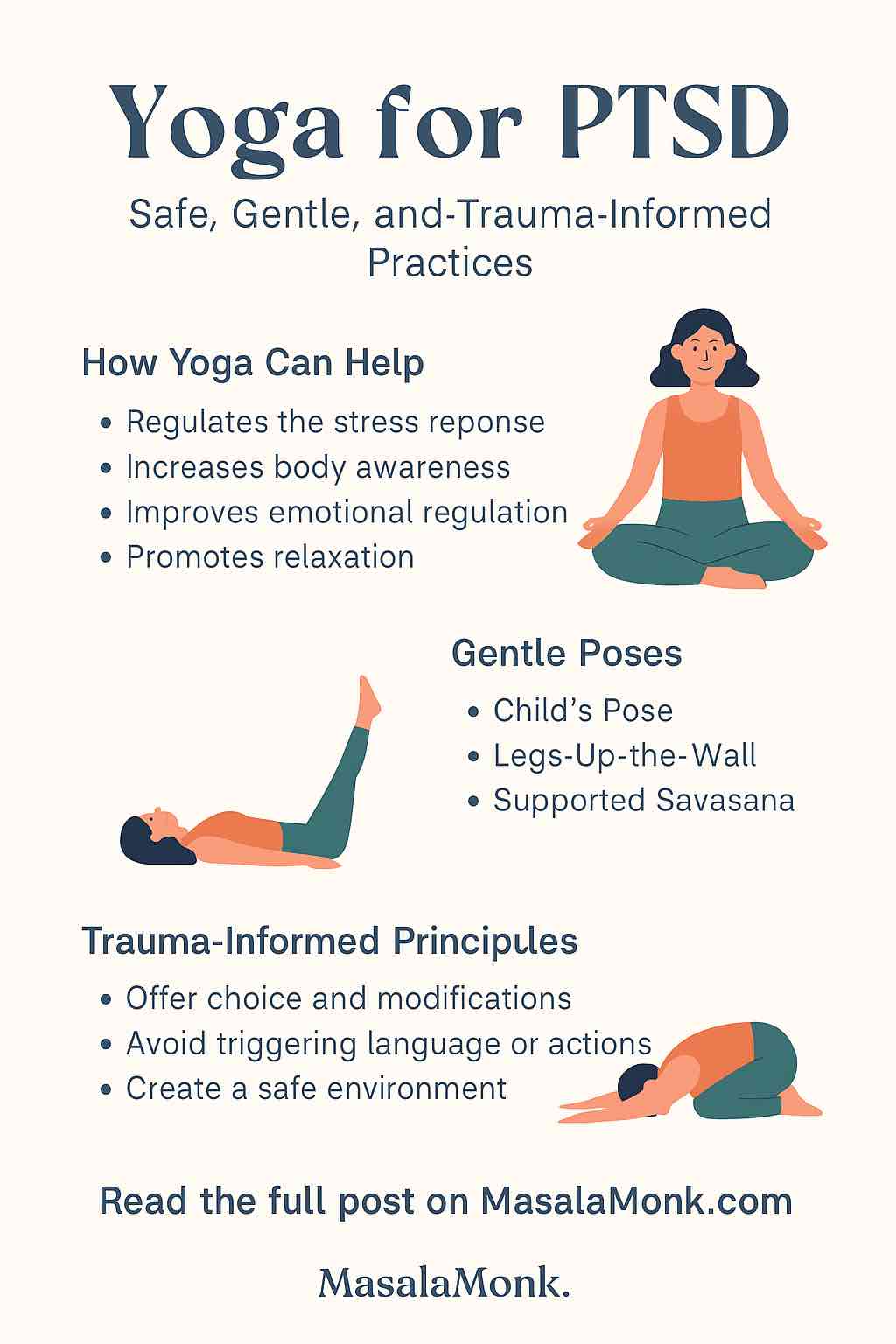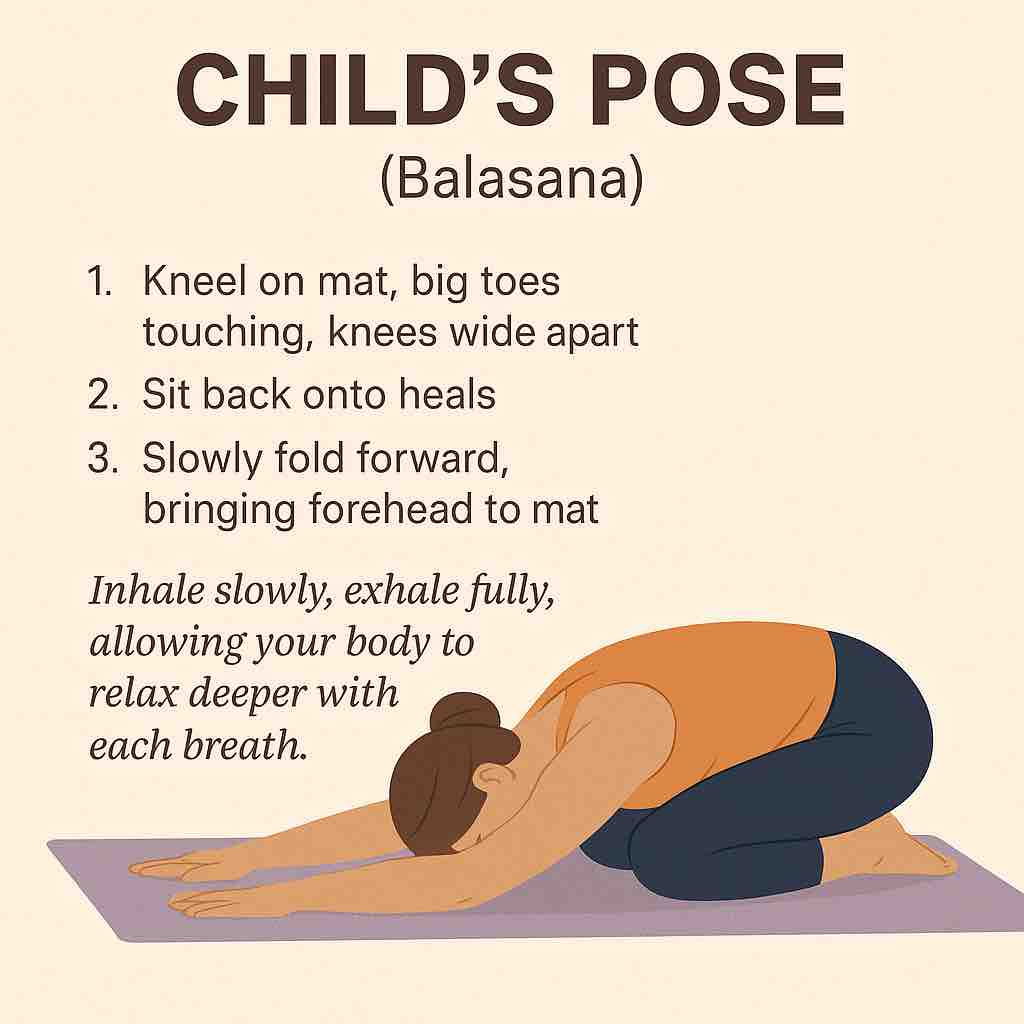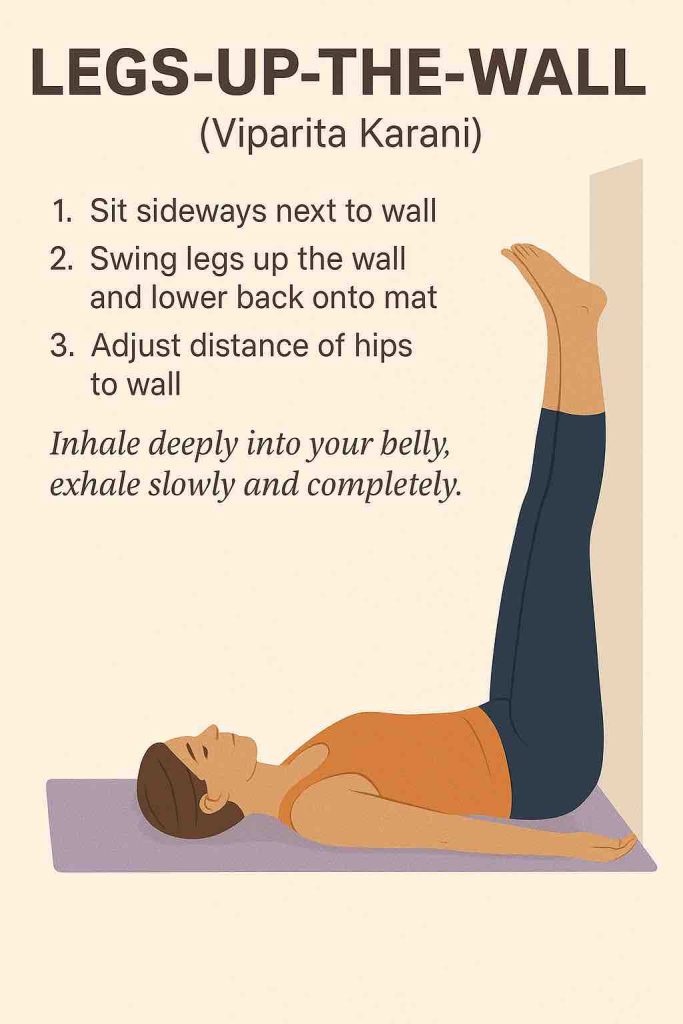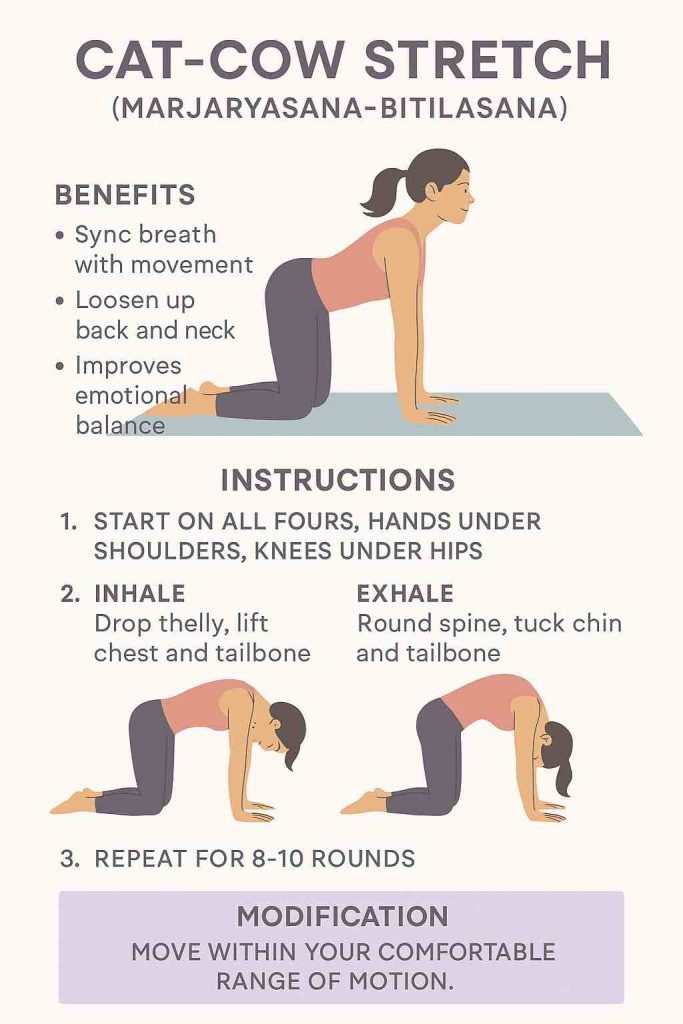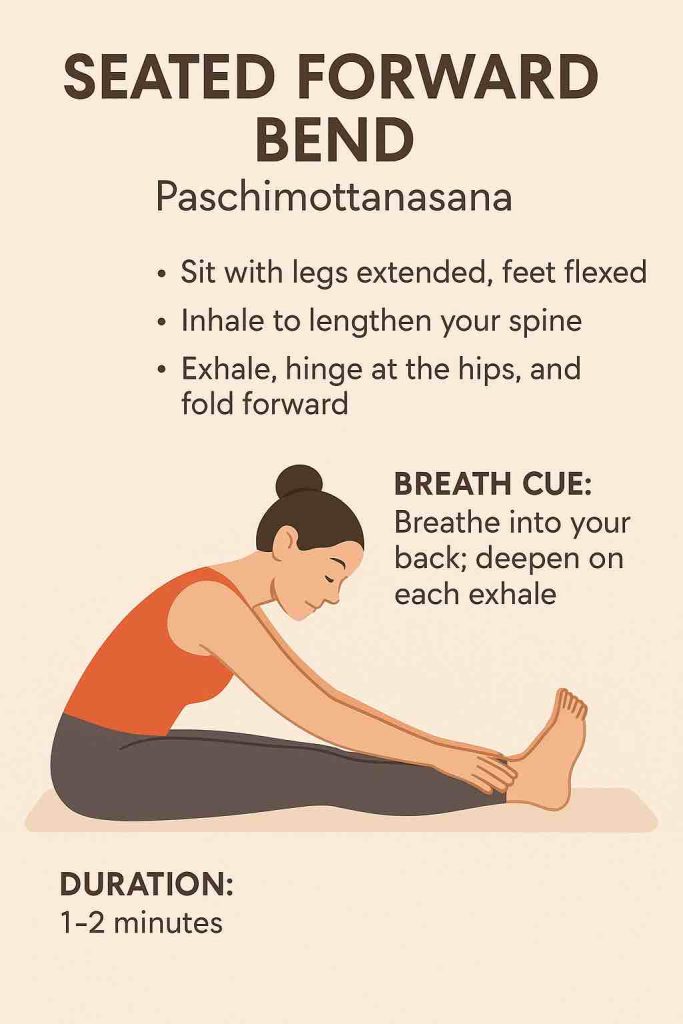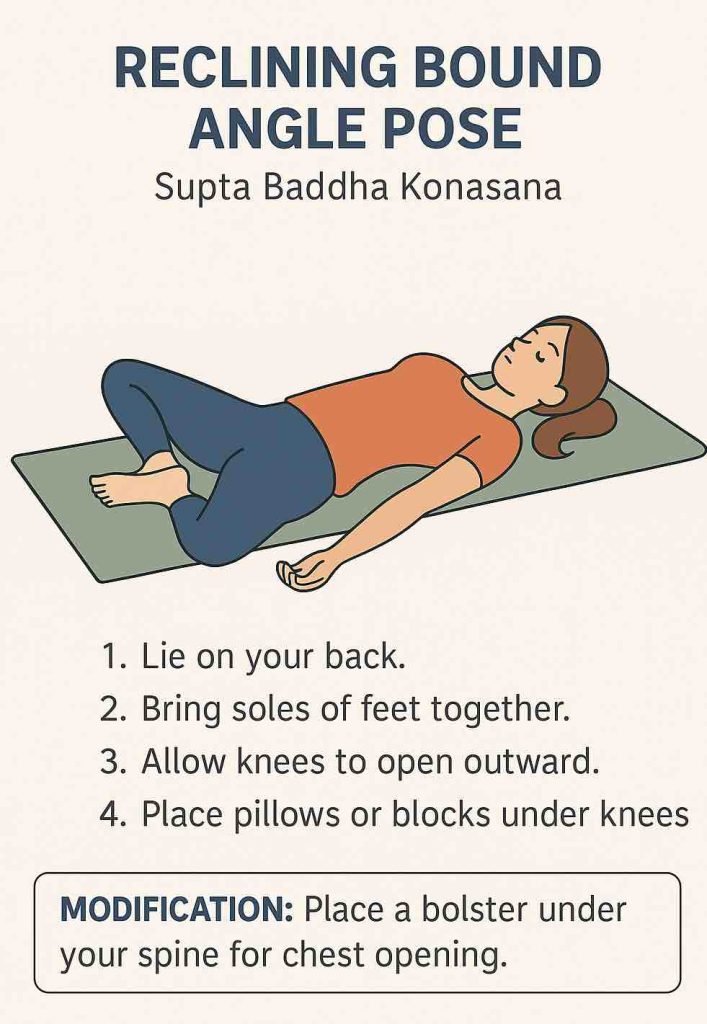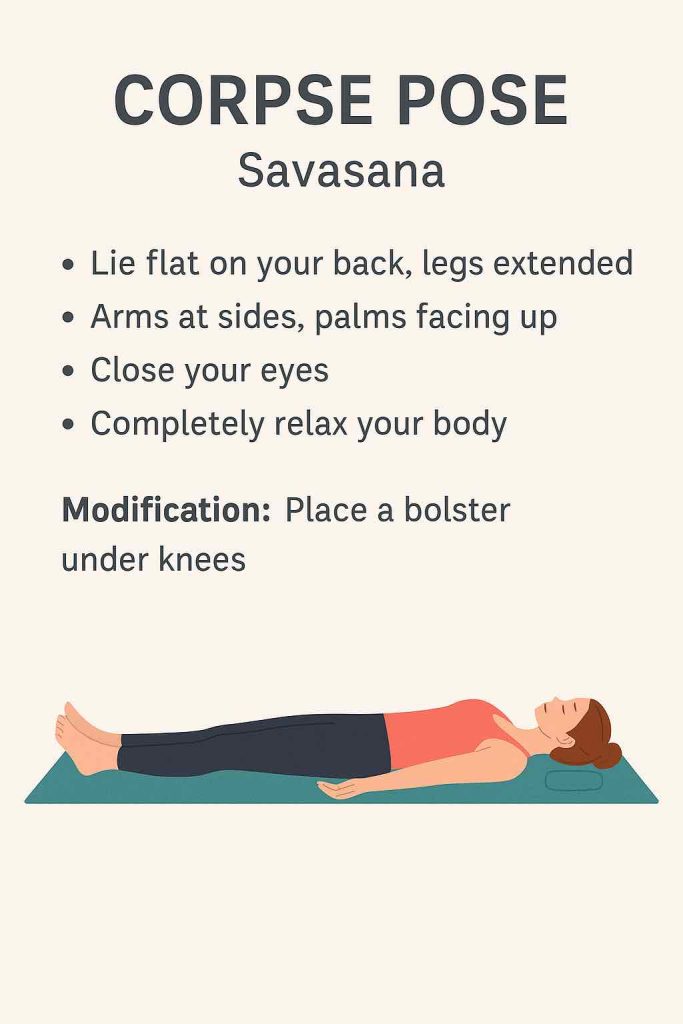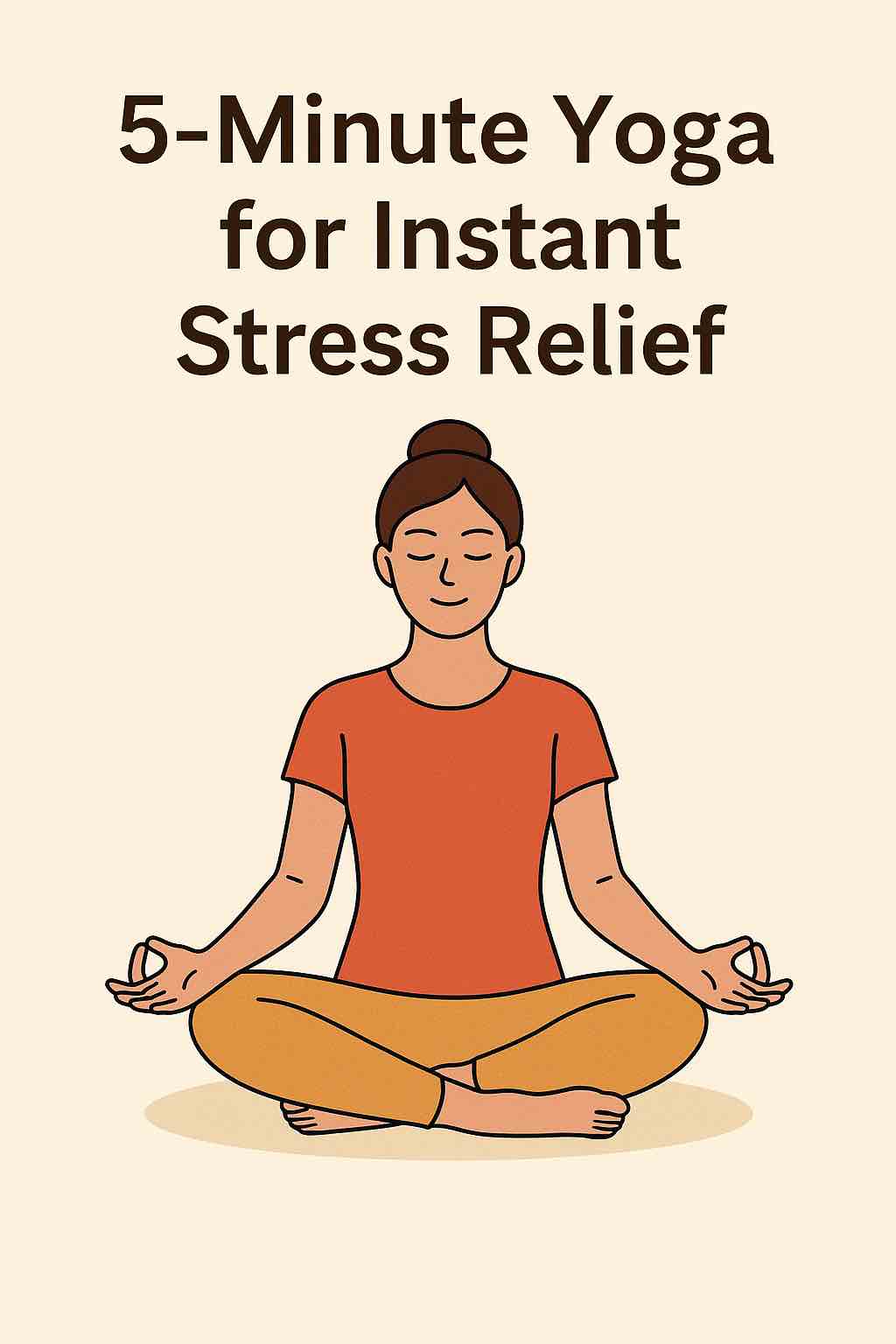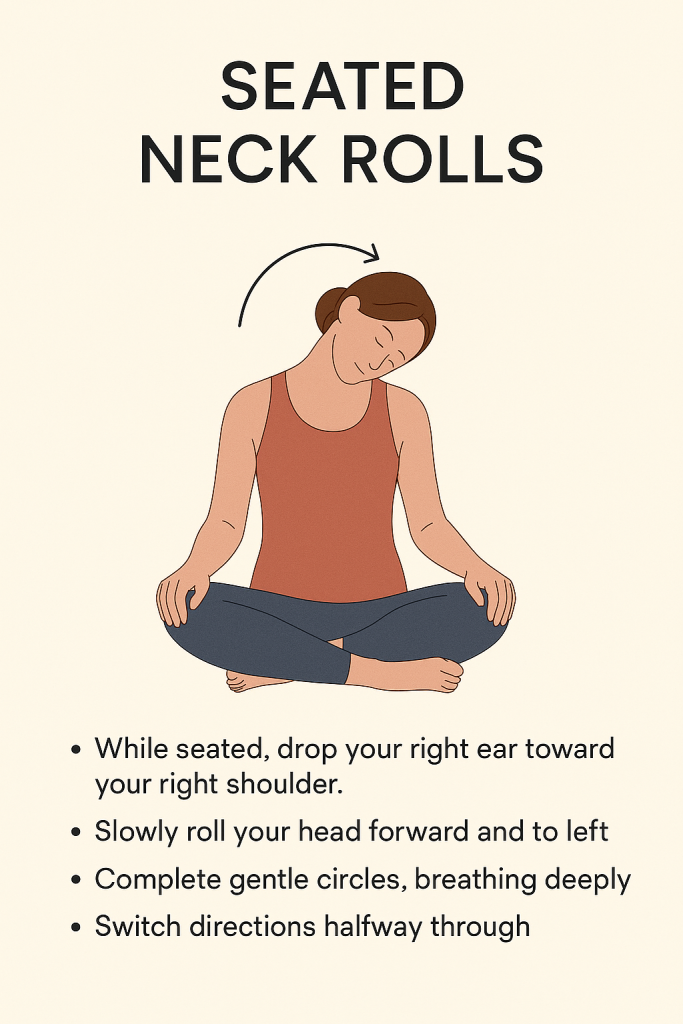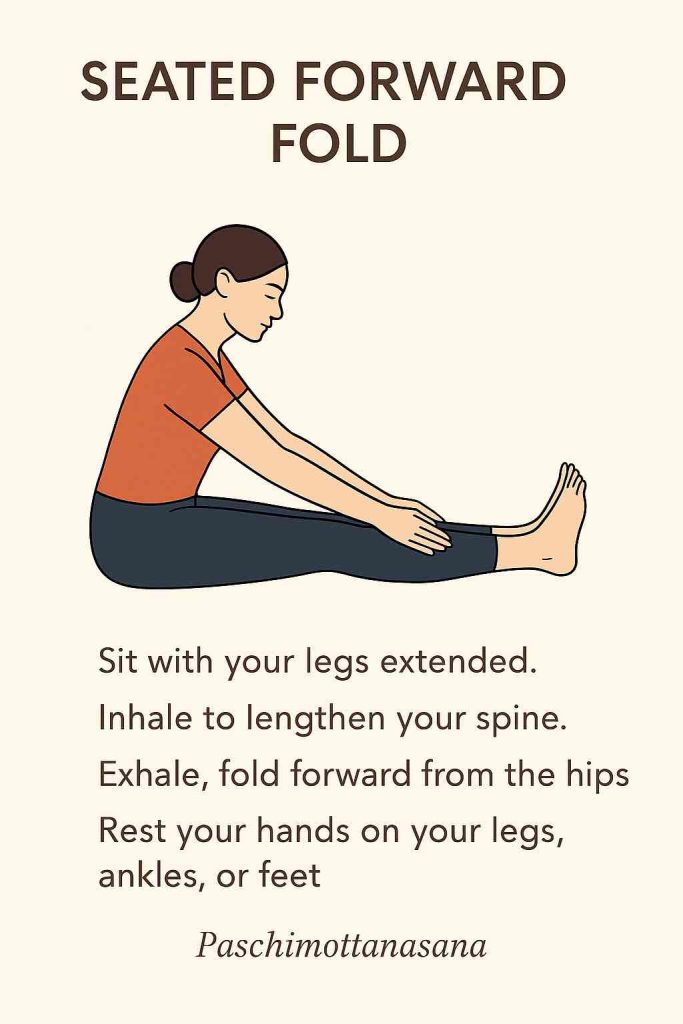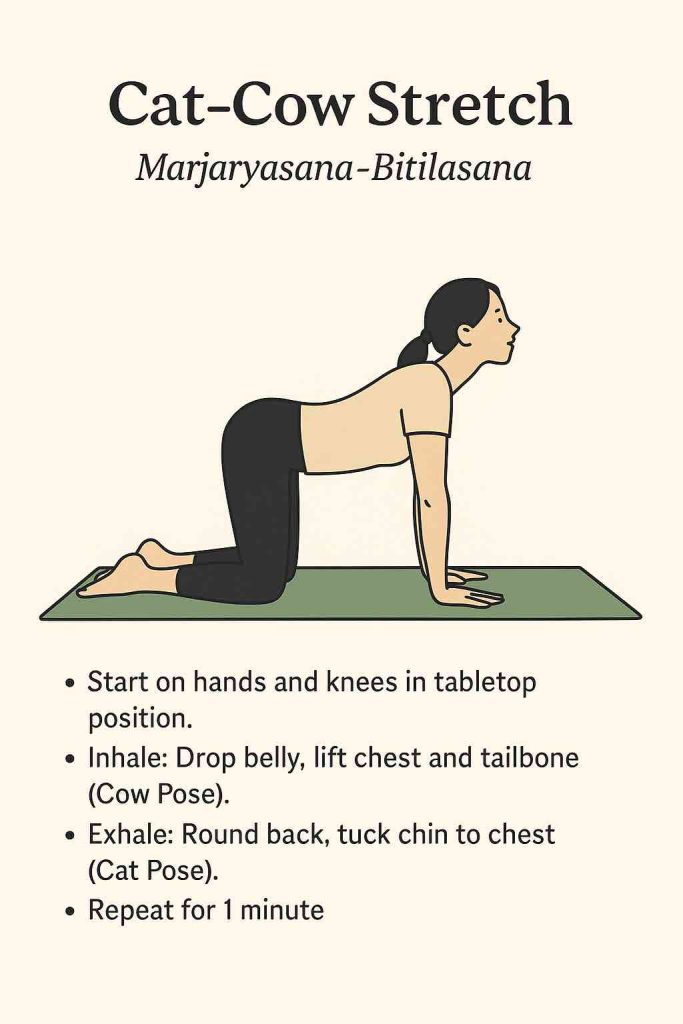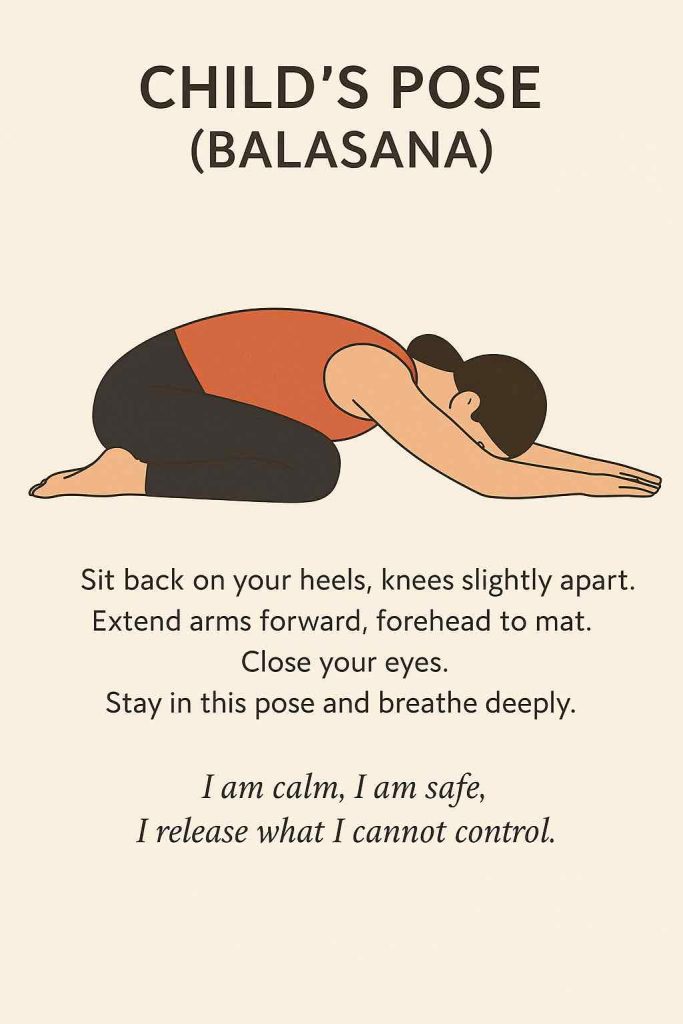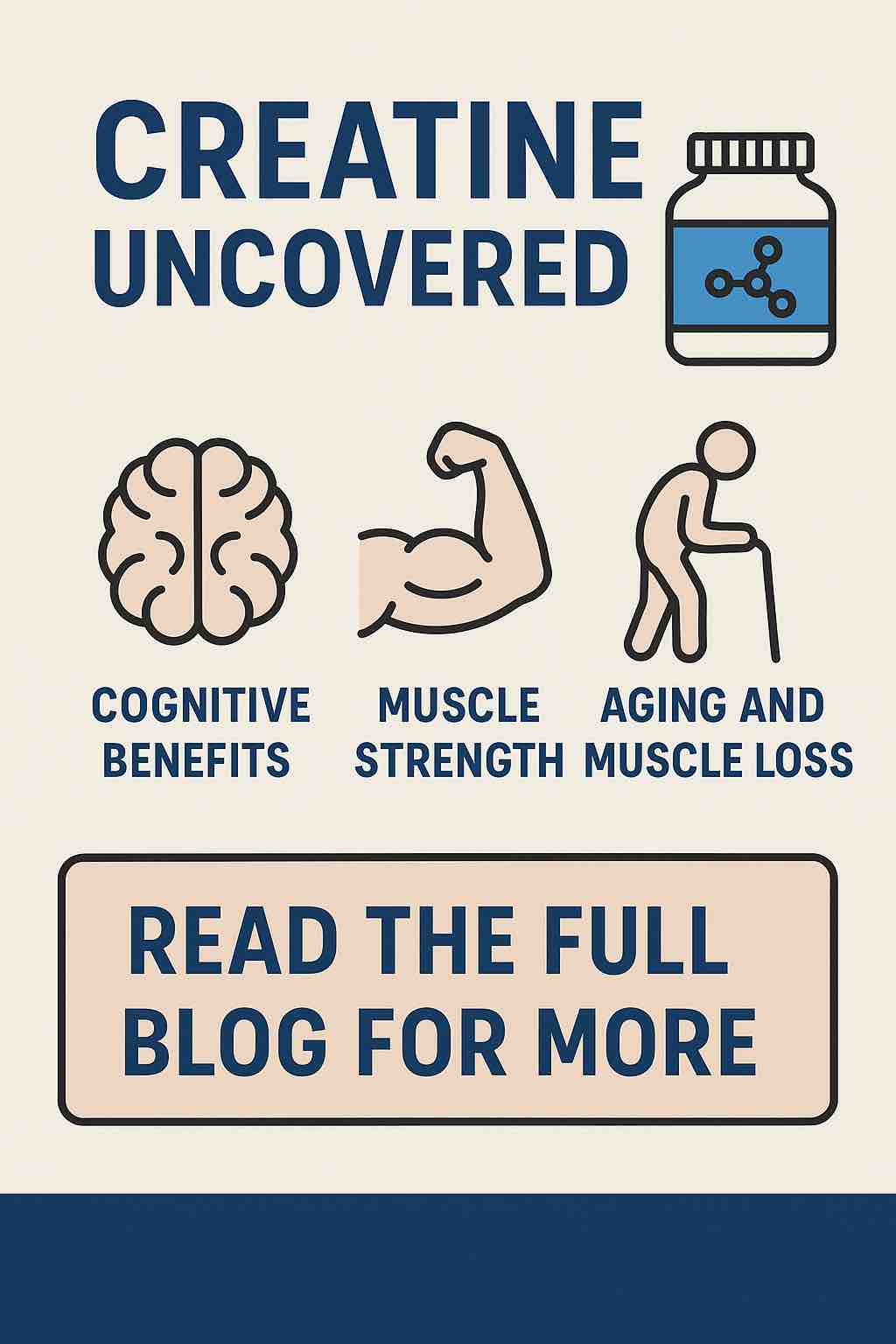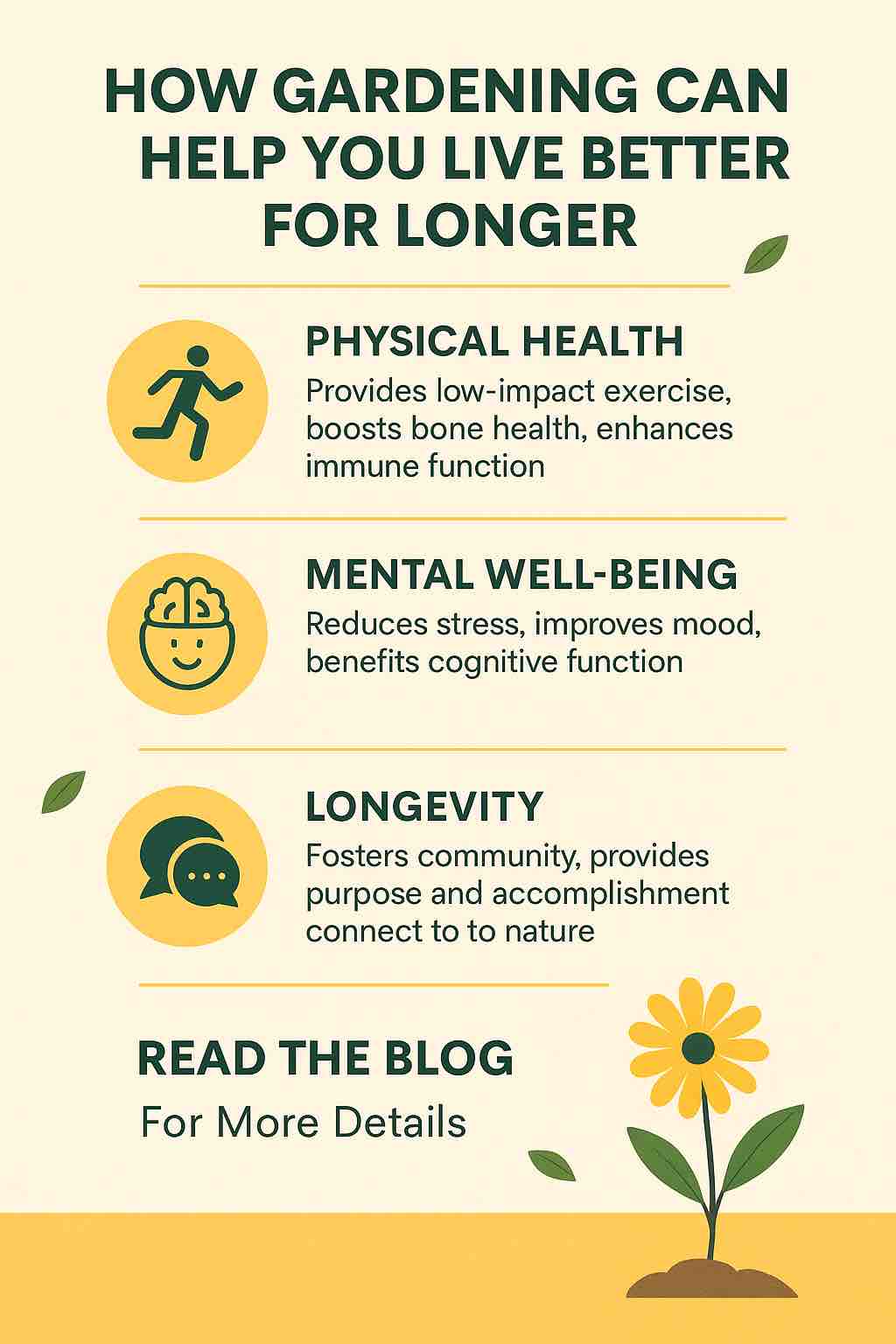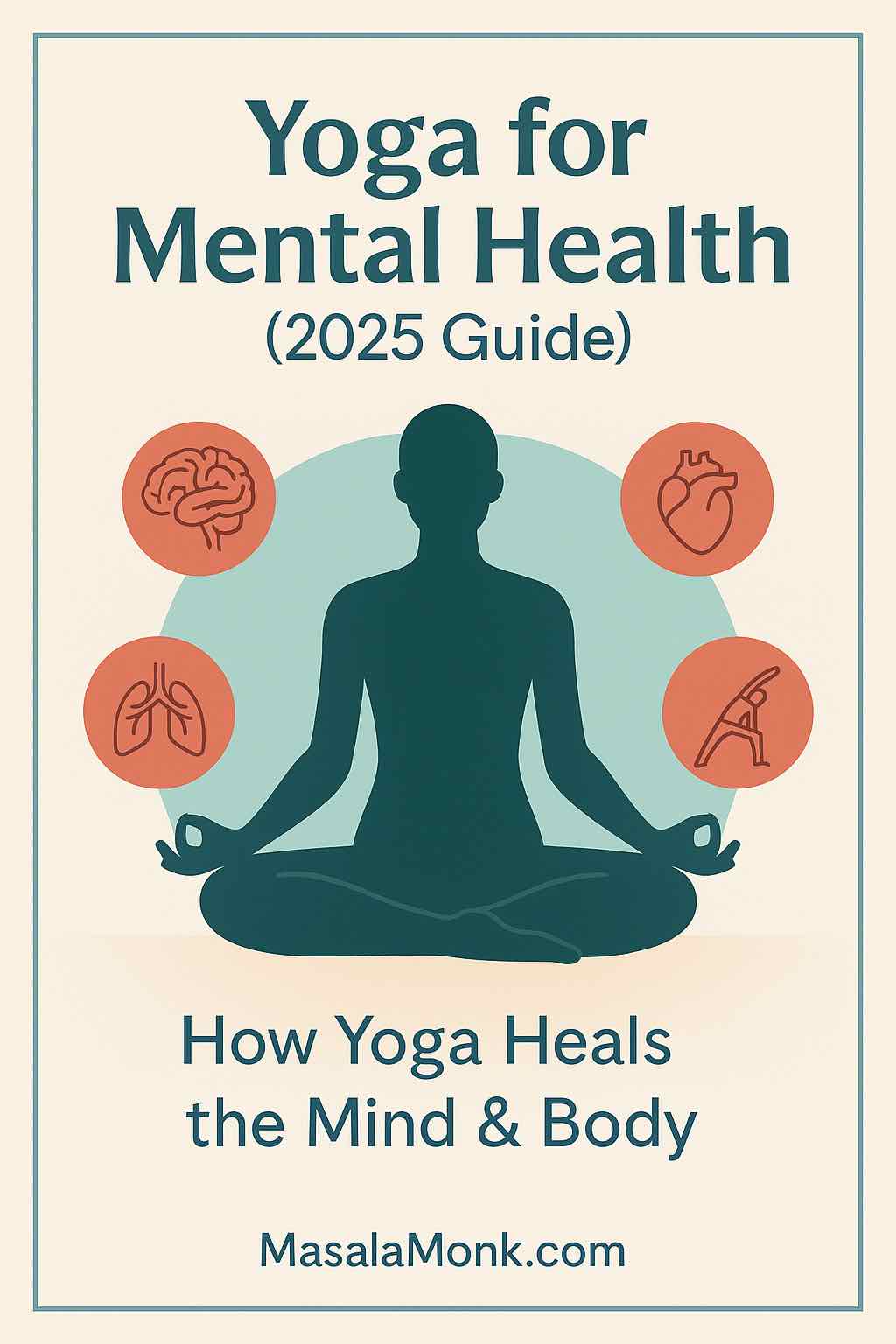
Mental health challenges are no longer rare, isolated, or limited to extreme cases. Anxiety, depression, bipolar disorder, PTSD, trauma, and emotional burnout now affect millions worldwide. While conventional treatments like psychotherapy, counseling, and medication play crucial roles, there’s an urgent need for more holistic approaches that address both mind and body.
One ancient system that has risen to meet this demand—validated by modern science—is yoga.
Far beyond stretching or spiritual practice, yoga is now widely recognized as a powerful tool for emotional regulation, nervous system balance, and mental healing. In recent years, dozens of studies, clinical trials, and real-world applications have shown yoga’s potential to reduce anxiety, calm trauma responses, stabilize mood disorders, and complement psychiatric treatment.
This comprehensive 2025 guide explains exactly how yoga works for mental health, which specific techniques help various conditions, and how professionals are being trained to safely integrate yoga into mental healthcare today.
How Yoga Works for Mental Health: The Science Explained
Yoga affects mental health because it works directly on the systems that control how we feel, react, and recover from stress. Instead of only addressing symptoms, yoga reaches into the brain, nervous system, hormones, and even immune function to help restore balance.
When someone experiences anxiety, depression, or trauma, it’s not just happening in their thoughts. These conditions are deeply linked to what’s happening in the body: rapid heartbeat, tight muscles, shallow breathing, racing thoughts, digestive problems, poor sleep, and constant fatigue. Yoga addresses all of these through breath control, mindful movement, and nervous system regulation.
One of the key systems yoga works on is the autonomic nervous system. This system has two main branches: the sympathetic nervous system (which activates the “fight or flight” response) and the parasympathetic nervous system (which activates the “rest and digest” state). In people struggling with anxiety, trauma, or chronic stress, the sympathetic system is often stuck in overdrive. Yoga helps shift dominance back to the parasympathetic side, which promotes calm, relaxation, and healing.
Breathing exercises (pranayama) play a central role here. Techniques such as alternate nostril breathing (Nadi Shodhana), humming bee breath (Bhramari), and slow diaphragmatic breathing directly stimulate the vagus nerve, which helps bring down heart rate, reduce blood pressure, and calm the mind. The vagus nerve acts like a brake on stress responses, and yoga helps train this system to function more effectively.
In addition to calming the nervous system, yoga directly influences brain chemistry. Research has shown that yoga increases levels of GABA (gamma-aminobutyric acid), a neurotransmitter that helps control fear and anxiety. Low GABA levels are often found in people with anxiety disorders, panic attacks, and depression. With regular yoga practice, GABA levels rise, providing a natural calming effect that supports mental stability.
Yoga also affects levels of serotonin and dopamine, two neurotransmitters closely linked to mood, motivation, and emotional well-being. Brain-derived neurotrophic factor (BDNF), a key chemical that supports brain plasticity and resilience, has also been found to increase with consistent yoga and meditation practice. Higher BDNF levels help the brain adapt to stress and recover from emotional challenges.
Modern imaging studies provide even more evidence. MRI scans show that people who practice yoga regularly have greater gray matter density in the prefrontal cortex, which governs decision-making, self-control, and emotional regulation. At the same time, yoga can reduce activity in the amygdala, the brain’s fear center, making emotional triggers less overwhelming over time.
Finally, yoga has a powerful anti-inflammatory effect. Chronic inflammation has been linked to depression, anxiety, and many physical health problems. Yoga helps reduce markers like interleukin-6 (IL-6) and C-reactive protein (CRP), lowering systemic inflammation and creating a healthier internal environment for both body and mind.
Through these multiple pathways — nervous system regulation, brain chemistry balance, structural brain changes, and reduced inflammation — yoga creates conditions in which healing can happen more naturally. This makes it an ideal complement to psychotherapy, counseling, medication, and trauma treatment, offering a full-body approach to emotional well-being.
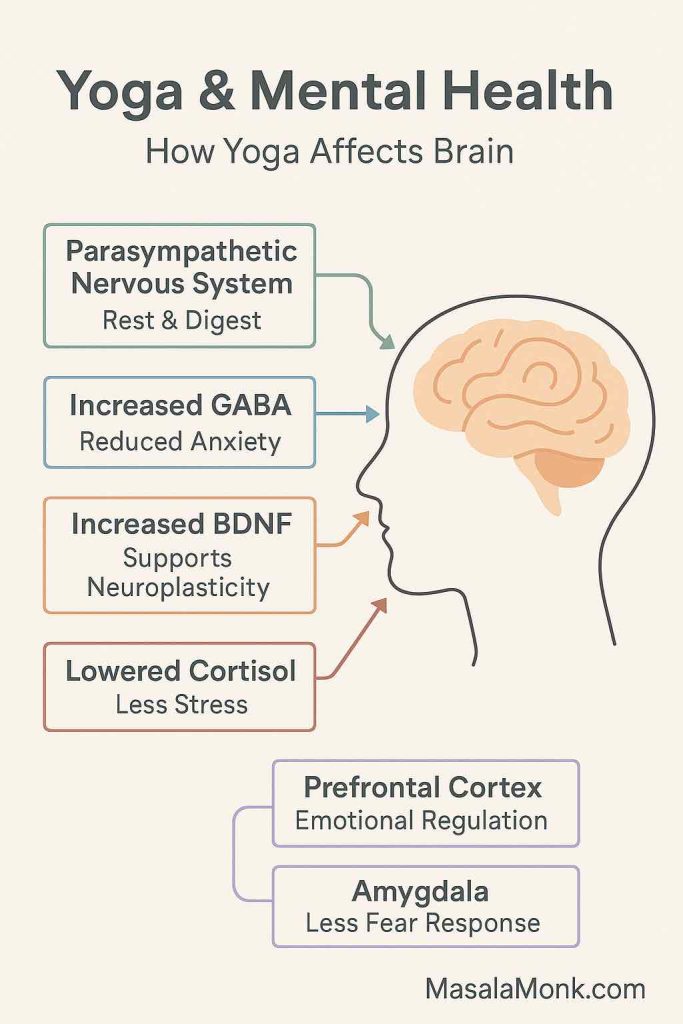
Yoga Practices for Specific Mental Health Conditions
One of the reasons yoga is becoming a key tool in mental healthcare is its flexibility. Different types of yoga practices can be tailored to help with specific mental health conditions. Whether someone is struggling with anxiety, depression, trauma, bipolar disorder, or even schizophrenia, the right approach to yoga can provide real benefits when properly integrated with professional care.
Yoga for Anxiety
Anxiety often feels like living with a body stuck in permanent overdrive — rapid heartbeat, racing thoughts, muscle tension, restlessness, and constant worry. Yoga works particularly well for anxiety because it calms both the body and mind simultaneously.
The most effective yoga styles for anxiety are gentle and restorative, allowing the nervous system to settle. Slow Hatha yoga, Iyengar yoga (which uses props for support), and restorative yoga are especially helpful. These styles avoid overstimulation and focus on breath, grounding, and relaxation.
Key practices include:
- Alternate nostril breathing (Nadi Shodhana) to balance brain hemispheres
- Humming bee breath (Bhramari) to calm the mind and reduce racing thoughts
- Poses such as Child’s Pose, Legs-Up-The-Wall, Cat-Cow stretch, and Savasana to relax the body
- Gentle guided meditations and body scans to build present-moment awareness
Studies confirm that consistent practice of these techniques can reduce Generalized Anxiety Disorder symptoms within weeks. Yoga also helps break the feedback loop between anxious thoughts and physical symptoms by teaching better body awareness and breath control.
Yoga for Depression
Depression often leaves people feeling drained, unmotivated, and emotionally numb. While medication and therapy remain crucial, yoga offers a way to slowly reactivate the body and mind.
Yoga for depression should gently energize the system while still being calming. Vinyasa flows, slow Sun Salutations, and gentle dynamic sequences can help build energy and motivation. Backbends such as Cobra pose and Bridge pose help open the chest and counter the slouched posture often seen in depressive states, physically lifting mood through movement.
Other useful techniques include:
- Morning yoga sequences to support daily rhythm and fight fatigue
- Breathing exercises such as Bhramari and slow belly breathing for relaxation
- Meditation and gratitude practices to cultivate positive emotion
Research shows that yoga boosts serotonin and dopamine levels, improves BDNF for brain resilience, and lowers inflammatory markers that can contribute to depressive symptoms.
Yoga for Trauma and PTSD
Trauma impacts both the mind and body, often leaving survivors stuck in hyperarousal or emotional shutdown. Trauma-sensitive yoga has been developed specifically to support trauma recovery by gently helping individuals reconnect with their bodies in a safe, controlled way.
Trauma-sensitive yoga differs from regular yoga because:
- It emphasizes personal choice and bodily safety
- Movements are simple, repetitive, and predictable
- Breath is guided carefully to avoid triggering overwhelming sensations
- Instructors are trained to create a safe, empowering environment without forceful adjustments
This approach helps regulate the nervous system, rebuild a sense of bodily safety, and reduce symptoms of hypervigilance, dissociation, and emotional numbness. Multiple clinical studies show that trauma-sensitive yoga can significantly reduce PTSD symptoms when used alongside therapy.
Yoga for Bipolar Disorder
Bipolar disorder presents unique challenges, as people swing between depressive lows and manic highs. Yoga can help stabilize mood but needs to be approached with care.
During depressive phases, more energizing yoga can support motivation. During manic or hypomanic episodes, grounding and calming practices are essential.
Best practices include:
- Gentle Hatha yoga and restorative poses to support emotional balance
- Avoiding highly stimulating practices during manic phases
- Emphasizing breath regulation and mindfulness throughout
While yoga alone cannot control bipolar disorder, studies suggest that it can improve emotional self-regulation, reduce depressive symptoms, and support overall stability when carefully integrated with professional treatment.
Yoga for Schizophrenia
In schizophrenia, yoga should always be used as a complement to medical care, not a replacement. Early research shows that carefully designed yoga programs can help improve cognitive function, attention, social engagement, and emotional regulation in people living with schizophrenia.
Safe practices include:
- Breath-centered Hatha yoga under professional supervision
- Simple body awareness exercises to improve interoception
- Mindfulness meditation focused on grounding and present-moment experience
Advanced spiritual practices or intense breathwork are generally avoided in this population to prevent destabilization. Studies, particularly in India, have shown improvements in cognitive functioning and social engagement when yoga therapy is used responsibly alongside psychiatric care.
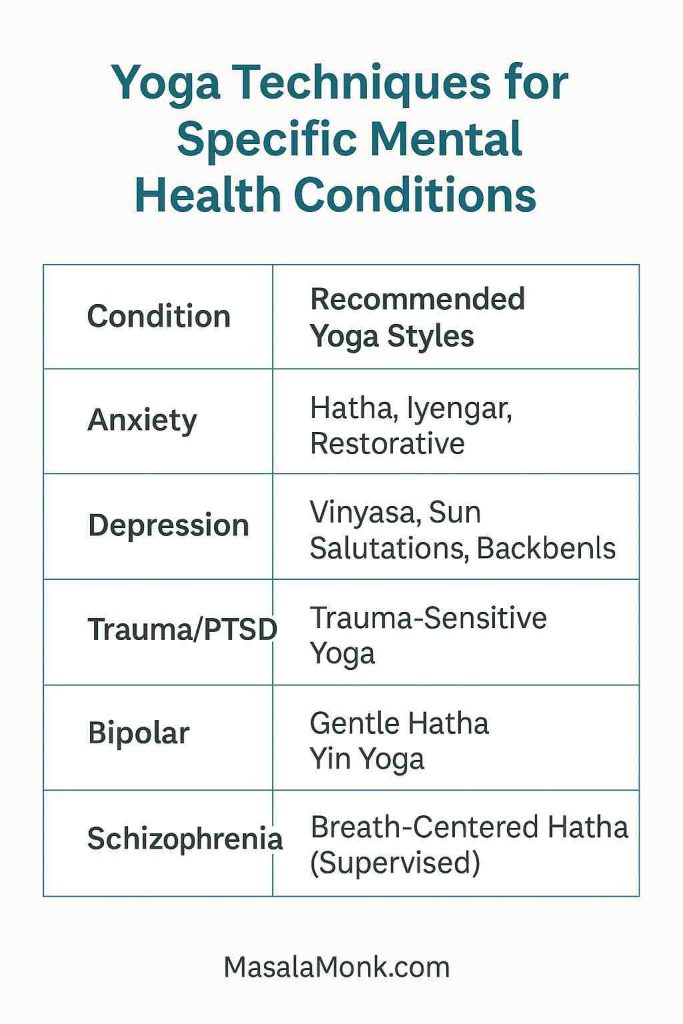
The Mental, Physical, Emotional, and Cognitive Benefits of Yoga
Yoga doesn’t just target one part of mental health—it works across multiple systems in the body and mind simultaneously. This full-spectrum effect is one reason it’s becoming so widely recommended in mental health care. Let’s break down how yoga benefits mental well-being across several key areas:
Mental Benefits
The most immediate mental benefit people experience from yoga is a reduction in anxiety, stress, and emotional reactivity. By calming the nervous system, yoga helps slow racing thoughts, ease mental tension, and improve emotional stability. People who practice regularly often report feeling more balanced, less overwhelmed by triggers, and better able to cope with everyday stressors.
Yoga also helps improve emotional regulation by strengthening parts of the brain responsible for managing mood, such as the prefrontal cortex. Over time, this leads to better decision-making, less impulsivity, and more thoughtful responses to emotional situations.
Many individuals who practice yoga consistently also experience fewer depressive episodes, reduced feelings of hopelessness, and better control over negative thought patterns. This is partly due to yoga’s effect on brain chemicals like serotonin, dopamine, and GABA, all of which are involved in regulating mood and emotional well-being.
Physical Benefits
Although yoga is often promoted for its mental benefits, its physical effects also play a major role in supporting mental health. The physical postures (asanas) improve flexibility, balance, and strength while releasing chronic muscle tension that can store emotional stress.
Physical improvements from yoga include:
- Lowered heart rate and blood pressure
- Improved respiratory capacity and lung function
- Better circulation and oxygen delivery
- Reduced chronic pain and muscle tightness
- Better digestion and gut health, which are both linked to mood and anxiety
Regular practice also helps improve sleep quality, which is one of the most important—and often most disrupted—aspects of mental health. People who struggle with insomnia, restless sleep, or fatigue often find that yoga helps restore more restful, deeper sleep.
Emotional Benefits
Yoga fosters emotional growth by increasing self-awareness, self-compassion, and mindfulness. Through breathwork and movement, individuals learn to observe their emotions without becoming overwhelmed by them. This builds emotional resilience—the ability to experience strong emotions while staying centered.
Mindfulness practices in yoga help people break the cycle of emotional reactivity. Instead of automatically responding to triggers, individuals learn to pause, breathe, and choose a response that aligns with their long-term emotional well-being. This skill is especially valuable for people dealing with trauma, anxiety, and mood disorders.
Group yoga classes also offer a sense of community and shared experience, which can help reduce feelings of isolation—a common struggle for many people living with mental health challenges.
Cognitive Benefits
Yoga’s effects on the brain go beyond mood and emotion—it also supports cognitive functioning. Regular practice has been shown to:
- Improve attention and concentration
- Sharpen memory and learning
- Increase cognitive flexibility (the ability to shift perspectives and problem-solve)
- Enhance neuroplasticity, allowing the brain to adapt more effectively to new experiences
For students, professionals, and older adults, yoga can serve as a cognitive “tune-up,” helping improve focus, clarity, and mental stamina.
By reducing systemic inflammation and supporting brain chemical balance, yoga creates a healthier environment for the brain to function at its best. These cognitive benefits are particularly important for people dealing with trauma, anxiety, or chronic stress, where cognitive performance often suffers.
The Full Mind-Body Integration
What sets yoga apart from many other interventions is its ability to address all these domains at once. It’s not just physical, or mental, or emotional—it’s a whole-body system that supports healing at every level. This integrated approach is what makes yoga so valuable as part of a comprehensive mental health plan.
When practiced consistently, yoga builds resilience—the capacity to handle stress, recover from setbacks, and maintain emotional balance even during difficult times. For people living with mental health challenges, this resilience can make the difference between struggling and thriving.
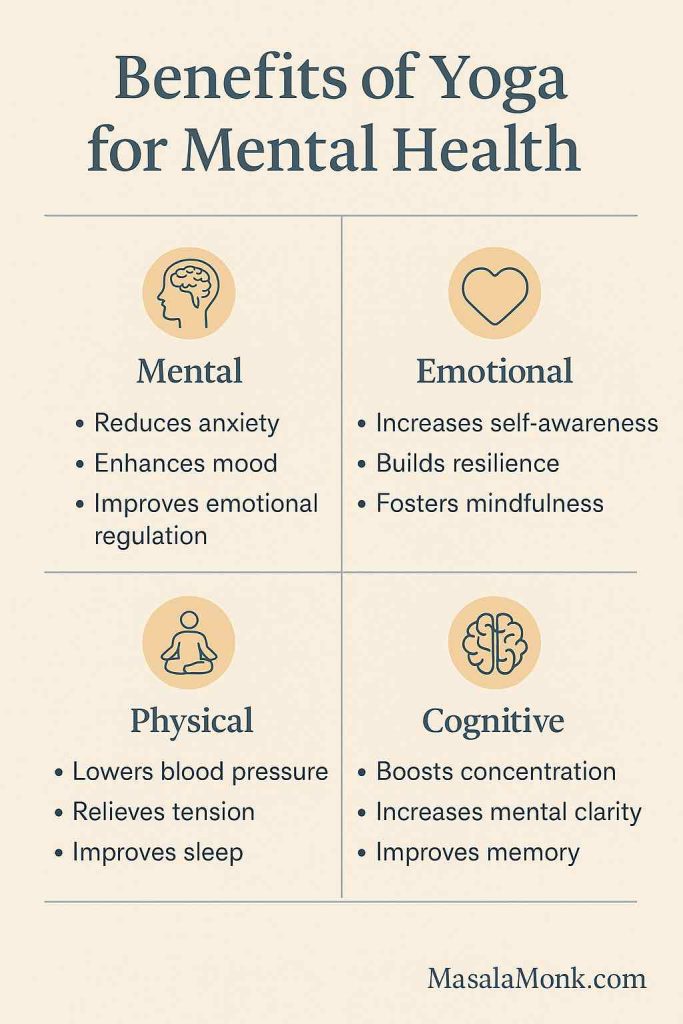
Yoga Certifications and Professional Training for Mental Health
As the role of yoga in mental health care continues to grow, more professionals are seeking specialized training to deliver these practices safely and effectively. Unlike general yoga teacher certifications, programs focused on yoga for mental health go deeper into understanding psychological conditions, trauma sensitivity, and how yoga techniques interact with the nervous system and brain.
Proper certification ensures that yoga instructors and mental health practitioners are equipped to handle vulnerable populations, adapt practices to different emotional states, and collaborate safely with other healthcare providers.
Why Specialized Yoga Training Is Important
Mental health populations have unique needs. A one-size-fits-all yoga approach can sometimes do more harm than good if not applied thoughtfully. For example:
- Certain breathing techniques may worsen anxiety if introduced too aggressively.
- Intense physical postures may overwhelm trauma survivors.
- Highly stimulating practices can be risky for people with bipolar disorder or psychosis.
Specialized training programs teach professionals how to adapt yoga for:
- Anxiety and panic disorders
- Depression and mood disorders
- Trauma and PTSD
- Bipolar disorder
- Schizophrenia and psychotic spectrum disorders
- Substance abuse and recovery
Training also covers how to create safe environments, recognize when to refer clients for additional care, and collaborate with therapists, psychiatrists, and medical teams.
Leading Yoga for Mental Health Certification Programs (2025)
Today, several respected programs offer comprehensive training in yoga therapy for mental health. Some of the most recognized include:
- IAYT (International Association of Yoga Therapists)
Considered the gold standard for yoga therapy worldwide. Their accredited programs involve hundreds of hours of clinical training, covering both physical and mental health applications. Graduates are qualified to work in hospitals, clinics, and private practice alongside medical professionals. - Stanford YogaX
A highly regarded program developed at Stanford University, designed specifically for healthcare providers. YogaX focuses on integrating yoga with psychotherapy, counseling, and medical treatment, with a strong foundation in neuroscience and trauma-informed care. - Kripalu Center for Yoga & Health
Kripalu offers multiple programs focused on trauma-sensitive yoga and therapeutic yoga for emotional well-being. Their training is popular among psychotherapists, social workers, and counselors who wish to incorporate yoga into their practice. - Patanjali Yoga (Baba Ramdev’s Institution, India)
Baba Ramdev has helped popularize yoga across India, and his institutions offer programs that address lifestyle diseases, stress management, and general emotional well-being. While widely accessible, these programs may not include the full depth of clinical mental health training found in therapeutic yoga certifications. - Isha Foundation (Sadhguru’s Institution, India)
The Isha Foundation’s programs, such as Inner Engineering, combine yogic practices with breathwork, mindfulness, and lifestyle changes. Many participants report emotional benefits, although these programs are not structured as formal clinical certifications. - Branches of Growth Mental Health Counseling & Yoga Studio (USA)
A growing example of integrated private practice, combining licensed counseling with yoga therapy for clients dealing with anxiety, depression, and trauma.
Who Should Pursue Yoga for Mental Health Certification?
- Mental health professionals: psychologists, psychotherapists, counselors, social workers
- Healthcare providers: doctors, nurses, occupational therapists, physical therapists
- Yoga teachers who want to specialize in therapeutic yoga
- Trauma specialists seeking to integrate somatic healing methods
- Wellness professionals interested in expanding their skill set to support emotional well-being
Key Topics Typically Covered in Certification
- Trauma-sensitive teaching techniques
- Breathwork for emotional regulation
- Neurobiology of stress and trauma
- Clinical applications for specific mental health disorders
- Scope of practice and ethical guidelines
- Safety protocols and contraindications
For anyone serious about working with mental health populations, professional certification is critical. Not only does it ensure safety and competence, but it also helps build trust with clients, medical teams, and regulatory bodies.
The Latest Research on Yoga for Mental Health (2025 Updates)
Over the past decade, research on yoga’s role in mental health has grown rapidly. In 2025, we now have stronger evidence than ever before showing that yoga is far more than just a lifestyle practice — it’s a scientifically validated therapeutic tool that positively impacts the brain, body, and emotions.
Researchers have examined yoga’s effects across a wide range of mental health conditions, using advanced neuroimaging, biochemical testing, and controlled clinical trials to measure its true impact.
Generalized Anxiety Disorder (GAD)
A landmark study published in JAMA Psychiatry (2025) demonstrated that individuals with GAD who participated in an 8-week structured yoga program experienced significant reductions in anxiety symptoms. The study also measured increased GABA activity on brain scans — directly linking yoga practice with the brain’s calming neurotransmitters.
Depression
Multiple meta-analyses published between 2024 and 2025 have confirmed that yoga provides moderate to large reductions in depressive symptoms, especially when combined with standard treatments like medication and psychotherapy. Researchers observed improvements in serotonin levels, cortisol reduction, and greater emotional regulation in yoga participants.
One 2025 NIH-funded trial found that a 12-week yoga and meditation program improved depression symptoms even in individuals who were resistant to traditional antidepressant medications.
PTSD and Trauma
Trauma-sensitive yoga remains one of the fastest-growing areas of yoga research. Several randomized controlled trials (RCTs) conducted in 2024 and 2025 found that trauma survivors who practiced somatic-focused yoga experienced significant reductions in PTSD symptoms, hyperarousal, and emotional dysregulation.
One major study with combat veterans reported not only improved PTSD symptoms but also better sleep quality and reduced emotional numbing after 16 weeks of trauma-informed yoga classes.
Bipolar Disorder
While fewer large-scale studies exist for bipolar disorder, recent observational studies from 2024 suggest that carefully designed Hatha yoga programs can reduce depressive episodes and help regulate mood stability. Researchers emphasized the importance of instructor supervision to avoid overstimulation during manic or hypomanic states.
Schizophrenia
Clinical trials from India and Europe have continued to explore yoga’s role as an adjunct treatment for schizophrenia. Results from 2025 confirm improvements in social functioning, emotional engagement, and cognitive skills such as attention, memory, and processing speed. However, these studies also stress that yoga should always remain part of a larger treatment plan under psychiatric care.
Biological Markers
Yoga’s influence on inflammatory markers has become one of the most scientifically intriguing areas of study. In 2025, several studies confirmed that yoga reduces markers such as interleukin-6 (IL-6), C-reactive protein (CRP), and tumor necrosis factor-alpha (TNF-alpha), all of which are elevated in individuals with chronic stress, depression, and anxiety.
Neuroimaging Studies
MRI and fMRI scans from recent research consistently show structural and functional brain changes after regular yoga practice:
- Increased gray matter density in the prefrontal cortex (responsible for executive function and emotion regulation)
- Decreased reactivity in the amygdala (reducing fear-based responses)
- Improved connectivity between brain regions involved in mood and cognition
Conclusion from 2025 Research
The scientific consensus is now stronger than ever: yoga produces real, measurable changes in brain function, hormone levels, inflammation, and emotional stability. While not a replacement for medical treatment, yoga stands as one of the most powerful complementary therapies available for mental health.
Frequently Asked Questions (FAQs)
Is yoga enough to treat mental health conditions on its own?
Yoga is a highly effective complementary therapy, but it should not replace professional treatment for serious mental health conditions. It works best alongside psychotherapy, counseling, medication, or other forms of medical care. For mild to moderate cases, yoga may offer significant symptom relief, but for more severe disorders, it should be part of a comprehensive treatment plan supervised by qualified healthcare providers.
Which type of yoga is best for anxiety and depression?
For anxiety, gentle Hatha yoga, Iyengar yoga (which uses props for support), and restorative yoga are highly effective. Breathing exercises like alternate nostril breathing (Nadi Shodhana) and humming bee breath (Bhramari) help regulate the nervous system.
For depression, slow Vinyasa flows, Sun Salutations, backbends like Cobra and Bridge pose, and heart-opening poses can help increase energy, motivation, and mood. Incorporating breathwork and mindfulness meditation further enhances these benefits.
Can yoga help with trauma and PTSD?
Yes, trauma-sensitive yoga has been shown to be highly effective in helping individuals heal from trauma and PTSD. These specialized programs focus on safety, choice, slow movement, and body awareness to help regulate the nervous system and reduce trauma symptoms. Trauma-sensitive yoga is most effective when used alongside trauma-focused psychotherapy.
Is yoga safe for people with bipolar disorder?
Yes, but it requires careful attention. During depressive phases, more energizing practices can be helpful. During manic phases, grounding and calming practices are safer. It’s important to avoid highly stimulating practices that might trigger mania. Working with a yoga therapist trained in mental health is strongly recommended for individuals with bipolar disorder.
What about schizophrenia? Can yoga be helpful?
Yoga can support individuals with schizophrenia when used as a supervised adjunct to medical care. Studies show improvements in cognitive functioning, emotional engagement, and social skills. However, advanced spiritual or intense breathwork practices should be avoided, and all programs should be led by instructors trained in mental health care.
Are there physical benefits to yoga that also help mental health?
Absolutely. Yoga improves flexibility, balance, strength, cardiovascular health, respiratory function, and sleep quality. Many physical symptoms of mental health conditions—such as muscle tension, headaches, gut issues, and insomnia—improve with regular yoga practice. By addressing both physical and mental symptoms, yoga supports total well-being.
Are there intellectual benefits of yoga?
Yes. Yoga improves cognitive flexibility, attention, focus, memory, and neuroplasticity. Studies have shown that regular yoga practice can enhance academic performance, improve decision-making, and sharpen concentration. This is particularly helpful for individuals with anxiety, trauma, or chronic stress who often struggle with cognitive fog.
Can mental health professionals get certified in yoga therapy?
Yes. There are now many specialized certification programs for yoga and mental health. Organizations such as the International Association of Yoga Therapists (IAYT), Stanford YogaX, Kripalu Center, and others offer professional training that integrates yoga therapy with clinical mental health care.
What are some well-known institutions offering yoga for mental health?
- Patanjali Yoga (Baba Ramdev, India): Known for promoting yoga’s role in managing lifestyle diseases and stress.
- Isha Foundation (Sadhguru, India): Combines yogic science with mindfulness, breathwork, and emotional well-being.
- Branches of Growth (USA): An example of a private counseling and yoga therapy practice offering integrated care.
Conclusion
In 2025, yoga has firmly established itself as one of the most valuable complementary therapies for mental health. What was once seen primarily as a spiritual or fitness practice is now backed by extensive research in neuroscience, psychology, and medicine. Yoga’s ability to regulate the nervous system, balance brain chemistry, reduce inflammation, and promote emotional resilience makes it uniquely suited to support people struggling with a wide range of mental health challenges.
Whether dealing with anxiety, depression, trauma, PTSD, bipolar disorder, or chronic stress, yoga offers tools that reach far beyond temporary symptom relief. It provides a practical, daily system for calming the body, quieting the mind, and building long-term resilience. Most importantly, yoga empowers individuals to participate actively in their own healing, giving them skills they can apply throughout life.
At the same time, yoga is not a replacement for professional mental health care. For those facing serious conditions, it works best as part of a comprehensive treatment plan that includes therapy, counseling, medication, or other medical interventions as needed. With proper guidance from trained professionals—whether yoga therapists, counselors, or medical providers—yoga becomes a powerful partner in mental health recovery.
The future of mental healthcare is no longer about choosing between Eastern or Western approaches—it’s about integrating the best of both. As more therapists, counselors, and healthcare providers pursue yoga for mental health certifications, more people will gain access to safe, effective, and evidence-based practices that support not only symptom management but full mind-body healing.
If you or someone you know is struggling with mental health challenges, consider exploring how yoga may fit into the broader picture of care. Start slowly, find qualified instructors or therapists, and take small steps toward building a practice that supports both your emotional and physical well-being. The research is clear: yoga works. And with each breath, each posture, and each moment of mindfulness, healing becomes more accessible.

